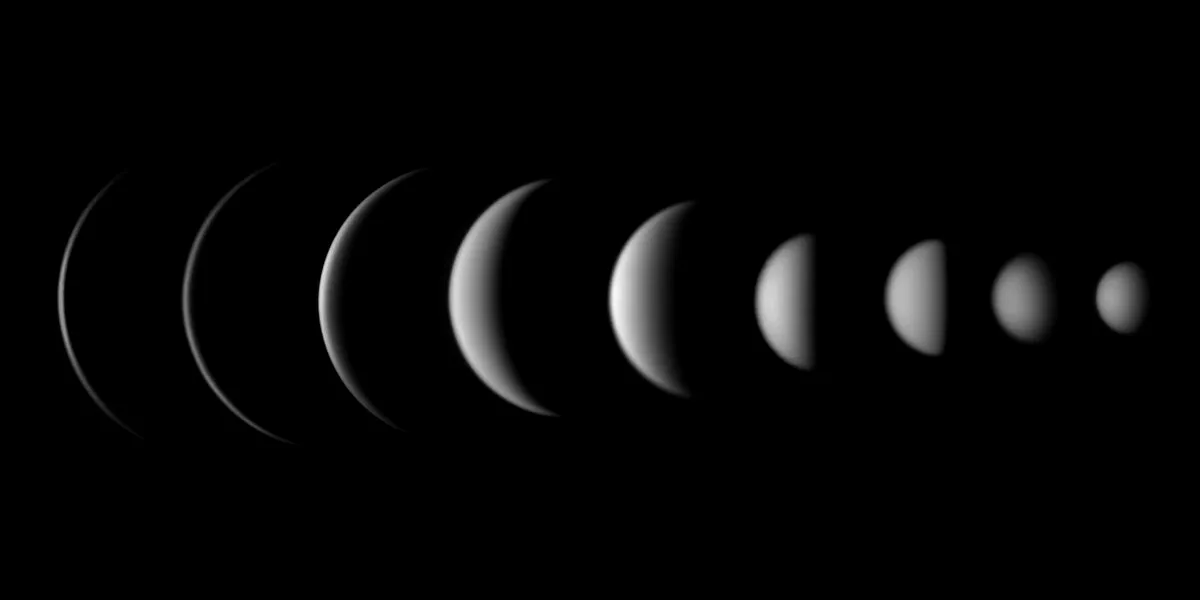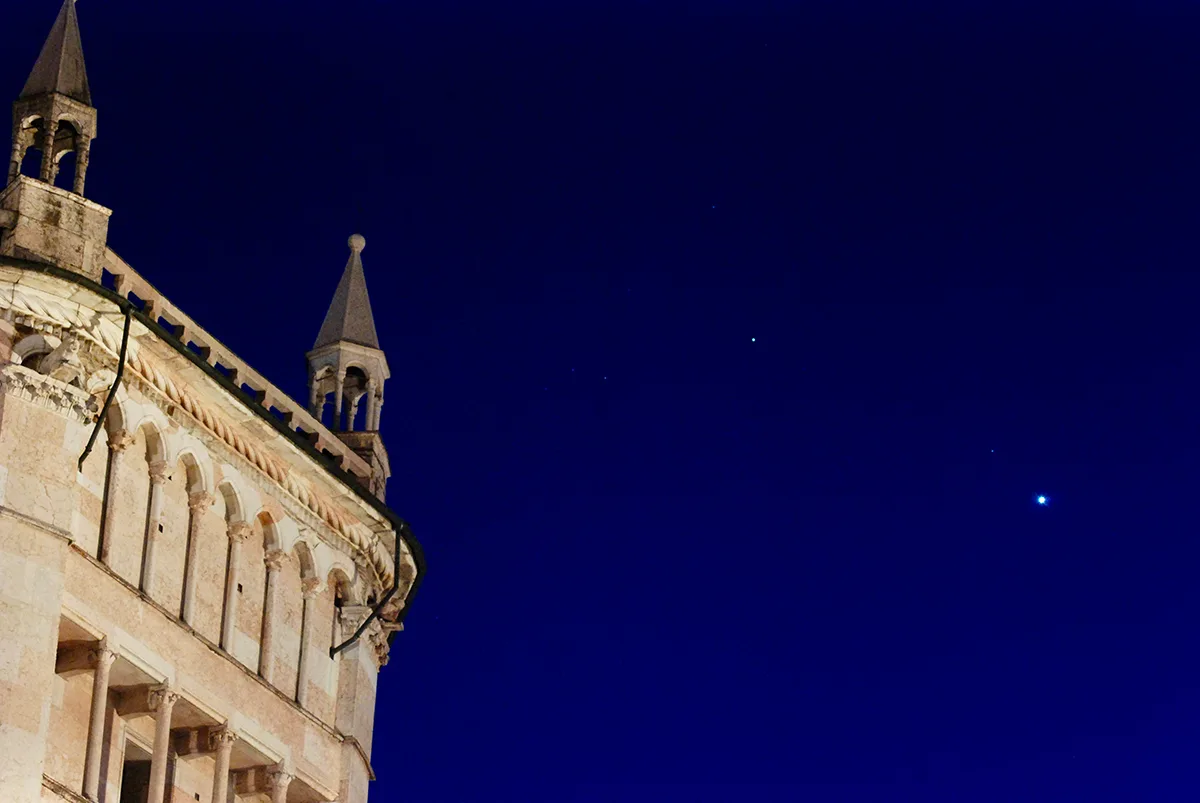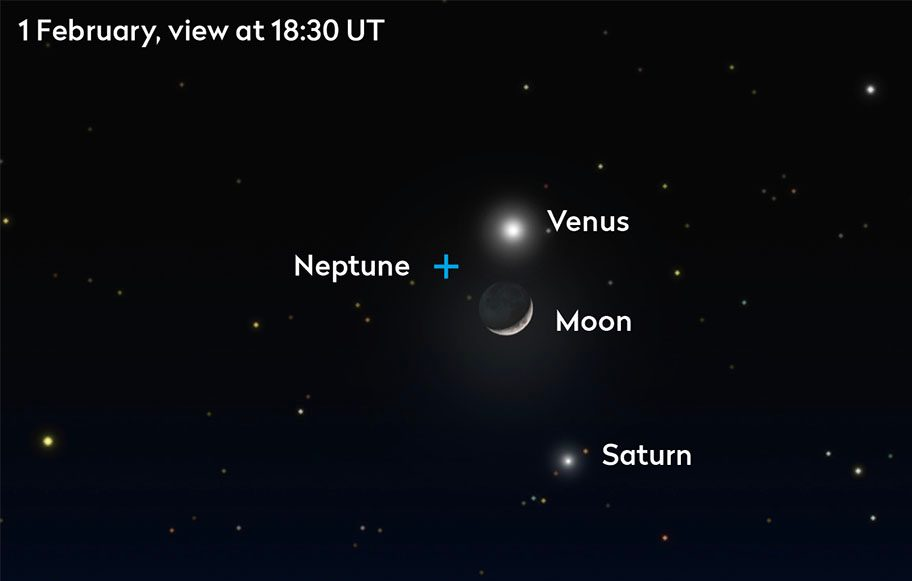If you’re looking up at the night sky tonight and wondering what those bright stars are next to the Moon, you’re actually looking at the planets Venus and Saturn.
Venus is the brightest ‘star’ in the night sky throughout February 2025, and is a wonderful sight to see in the evening twilight.
It emerges as dusk falls, and is likely the first ‘star’ you’ll see as nighttime approaches.
Get weekly stargazing advice by listening to our Star Diary podcast and signing up to receive the BBC Sky at Night Magazine e-newsletter.
 Venus, Saturn and Neptune appear next to the Moon on 1 February 2025. Credit: Pete Lawrence
Venus, Saturn and Neptune appear next to the Moon on 1 February 2025. Credit: Pete Lawrence
On 1 February, Venus sets below the horizon 4 hours and 24 minutes after the Sun.
Before the planet sets, you’ll see a 13%-lit crescent Moon 3.3° to the south of Venus at 20:00 UT.
This is a beautiful naked-eye spectacle, but Venus looks even more incredible when seen through a telescope.
Venus exhibits phases, just like our Moon, and tonight Venus is a 37%-lit crescent.
Saturn is just below the Moon this evening, also shining like a bright star, but less bright than Venus.
And if you get a good pair of binoculars or a telescope, you’ll be able to spot Neptune too, the most distant planet in our Solar System.
It’s not visible with the naked eye, but you can use the diagrams on this page to help you locate it with your telescope.
But of course, planets aren’t visible for just one night!
Venus, Saturn and Neptune are visible throughout February, but it will get more tricky to see them as March approaches.
Let’s see what the rest of the month has in store.
 Mars, Jupiter, Uranus, Venus and Saturn captured by Rob Abbott, Essex, UK, 23 January 2025. Note Venus and Saturn’s positions relative to one another.
Mars, Jupiter, Uranus, Venus and Saturn captured by Rob Abbott, Essex, UK, 23 January 2025. Note Venus and Saturn’s positions relative to one another.
Venus is a dramatic sight visible shortly after sunset. It’s located in Pisces in the southwest.
At the start of February, Venus shines very bright (mag. –4.5, to be precise), and you’ll be able to catch it against a dark sky.
As February progresses, Venus remains brilliant and well-placed in the sky, but observing it will get trickier as the weeks go by and the days get longer.
On 15 February, Venus still sets 4 hours after the Sun and is still bright (mag. –4.5).
But by 28 February, Venus is moving back towards the Sun, and springtime approaching will make things tricky.
Venus will set 3 hours and 15 minutes after sunset and be low in the sky by the time darkness falls.

If you’re observing with family or beginners, point out the planet, describing how it’s a similar size to Earth but is shrouded in thick clouds and very inhospitable to life.
Venus is showing a crescent phase, which is visible through a telescope.
If you do have binoculars or a telescope, ask your observer(s) whether they can see anything special about the planet.
If you have a group, ask each one to make a sketch, then compare the results once everyone has completed the task.
 Venus and Saturn seen over the Baptistery of Parma, Italy, 17:50 CET on 13 January 2025. Credit: Chris Dixon
Venus and Saturn seen over the Baptistery of Parma, Italy, 17:50 CET on 13 January 2025. Credit: Chris Dixon
Like Venus, the best time to see Saturn in February 2025 is at the start of the month.
It’s located near Venus in Aquarius, in the southwest. It will be bright at the start of February (mag. +0.8), visible in the deep twilight.
By the end of February 2025, it’s setting in the west, just shortly after the Sun, making it unviable for observing.
In other words, enjoy it while you can!
 It’s not all over for Neptune and Saturn this year! Early risers on 19 June 2025 get to see the last quarter Moon near Saturn with Neptune close by. Credit: Pete Lawrence
It’s not all over for Neptune and Saturn this year! Early risers on 19 June 2025 get to see the last quarter Moon near Saturn with Neptune close by. Credit: Pete Lawrence
Neptune, like Venus and Saturn, is best seen in February 2025 at the beginning of the month, and is visible in the southwest in Pisces.
On 1 February 2025, Neptune is near Venus, and you’ll need binoculars or a telescope to observe it, because it can’t be seen with the naked eye.
It’s mag. +7.9 at the start of February, which is beyond naked-eye visibility, and will rapidly become unobservable from there on.
If you’ve been observing or photographing the planets this month, don’t forget to send us your images and they could appear in a future issue of BBC Sky at Night Magazine.
